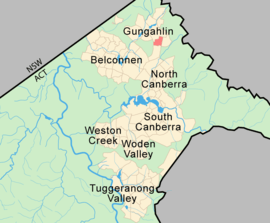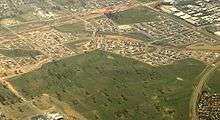Franklin, Australian Capital Territory
Franklin (postcode: 2913) is a suburb of Canberra, Australia in the district of Gungahlin. It is named after the novelist Miles Franklin. The streets in Franklin are named after writers.[2] It comprises an area of approximately 256 hectares. It is bounded by Flemington Road to the north and east, Well Station Drive to the south, and Gungahlin Drive to the west.[3] Franklin is mainly a residential area with higher density, mixed-use development along Flemington Road including a local shopping centre and other retail and commercial tenancies.
| Franklin Canberra, Australian Capital Territory | |||||||||||||||
|---|---|---|---|---|---|---|---|---|---|---|---|---|---|---|---|
Franklin wetlands | |||||||||||||||
 | |||||||||||||||
| Coordinates | 35°12′00″S 149°08′33″E | ||||||||||||||
| Population | 6,419 (2016 census)[1] | ||||||||||||||
| • Density | 2,790/km2 (7,230/sq mi) | ||||||||||||||
| Established | 2007 | ||||||||||||||
| Postcode(s) | 2913 | ||||||||||||||
| Area | 2.3 km2 (0.9 sq mi) | ||||||||||||||
| District | Gungahlin | ||||||||||||||
| Territory electorate(s) | Yerrabi | ||||||||||||||
| Federal Division(s) | Fenner | ||||||||||||||
| |||||||||||||||
Open space
The suburb of Franklin includes a number of large open space to provide a pedestrian and cyclist network, and to provide an ecological corridor for the movement of native wildlife.[3]
- The Gubur Dhaura Heritage Site provides 360 views of the surrounding landscape and an ochre quarry site which are of cultural significance to the Ngunnawal people. Remains of the Red Hill pipeclay mine, Old Well Station Track and historical markers can also be found here;[4]
- The Mulangarri and North Mitchell Grasslands;
- The Gungaderra Creek;
- Old Well Station Track which connects the Well Station Heritage Precinct (located in the neighbouring suburb of Harrison) with the Gungaderra Homestead, and Gubur Dhaura Red Hill Heritage Site through to the Gungahlin Town Centre.
Demographics
In the 2016 census, the population of Franklin was 6,419, including 75 (1.1%) Indigenous persons and 3,129 (49.2%) Australian-born persons.[1] 11.1% were born in China, 7.2% in India, 2.9% in South Korea, 2.2% in Sri Lanka, and 2.2% in Vietnam.[1] In the 2011 census, 44.4% of the population was foreign born, the third highest for any Canberra suburb.[5]
Transport
Light rail
Franklin is serviced by three Canberra Metro light rail stations located on Flemington Road at Manning Clark North, Mapleton Avenue and Nullarbor Avenue, that opened in April 2019.[6]
Geology
Franklin is underlaid mostly by the Canberra Formation mudstone or volcanics from the late middle Silurian age.[9]
Education
Franklin residents get preference for:[10]
- Franklin Early Childhood School
- A shared PEA of Harrison School and Palmerston District Primary
- Harrison School
- Gungahlin College
References

- Australian Bureau of Statistics (27 June 2017). "Franklin (State Suburb)". 2016 Census QuickStats. Retrieved 27 June 2017.

- "Suburb Name search results". ACT Environment and Sustainable Development. Retrieved 10 February 2014.
- Gungahlin Development Authority (2006), Franklin Residential Estate Concept Plan, ACT Planning and Land Authority
- "Heritage (Decision about Registration for Gubur Dhaura – Aboriginal Ochre Quarry and Historic Mining Area). Notice 2011" (PDF). Australian Capital Territory Heritage Register. Retrieved 9 March 2019.
- "Where do migrants live? (4102.0 - Australian Social Trends, 2014)". Australian Bureau of Statistics. 17 March 2014. Retrieved 19 March 2014.
- "Using light rail". Transport Canberra. Retrieved 24 June 2019.
- Route 18 Transport Canberra
- Route 21 & 22 Transport Canberra
- Henderson G A M and Matveev G, Geology of Canberra, Queanbeyan and Environs 1:50000 1980.
- "Priority Enrolment Areas 2015 by Suburb Archived 8 February 2016 at WebCite" (Archive). Education Directorate, Australian Capital Territory. Retrieved on 8 February 2016.
| Wikimedia Commons has media related to Franklin, Australian Capital Territory. |